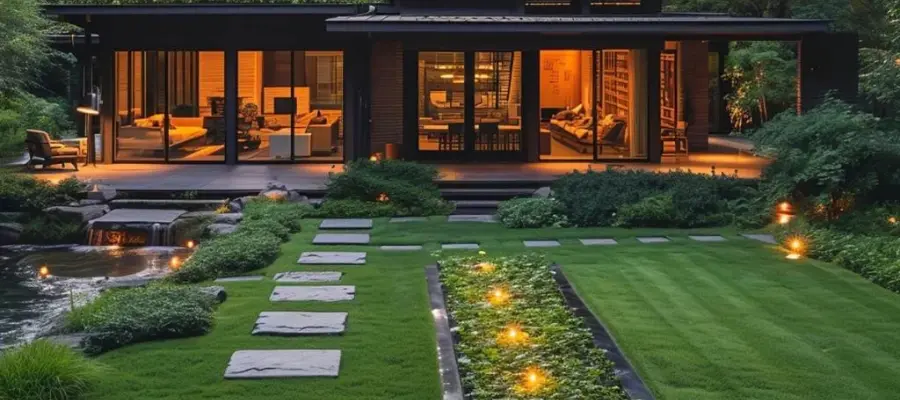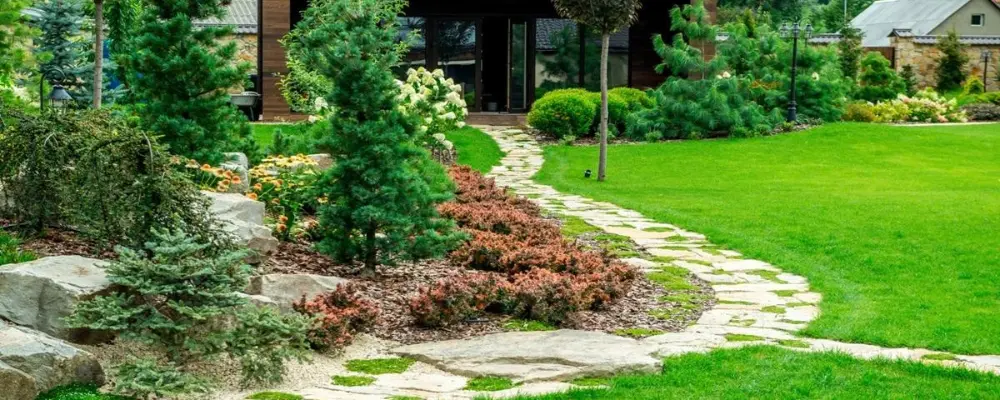Sustainable landscapes are gaining popularity in today’s modern era due to more and more urban development and rising environmental issues. Sustainable landscaping is more than just beautiful landscaping; it’s an integrated approach that balances human activity with the environment, supporting biodiversity conservation, ecological balance, and community well-being. The fundamentals of sustainable landscaping provide an approach towards a more resilient and environmentally friendly future, whether in suburban gardens or urban parks.
So, in this blog, Brick & Bolt serves detailed info about sustainable landscaping practices or eco-friendly landscaping, including water conservation landscaping
mulching landscaping, composting landscaping, erosion control landscaping, carbon absorption landscaping, etc.
What is Sustainable Landscaping Practice?
Using a variety of techniques to design a landscape that is both climate and environmentally friendly is known as sustainable landscaping or eco-friendly landscaping. A few of the main objectives and advantages of sustainable landscaping are the absorption of carbon dioxide, enhanced soil health, reduced labour costs and organic waste production, water conservation, and habitat creation through carefully chosen plants.
Transitioning to sustainable landscaping protects our local ecosystems and reduces pollution of the air, water, and soil. As a result, maintenance requirements and long-term costs may decrease. Sustainable landscaping includes warm, arid cactus and gravel gardens, edible plants like mangoes and pomegranates, lovely local flowering plants, and shade trees that help to cool your house. In addition to protecting the environment and offering food for wildlife, birds, and bees, a well-designed sustainable garden or yard immediately benefits nearby communities.
9 Sustainable Landscaping Practices

The following are the sustainable landscaping practices:
- Water Conservation
- Mulching
- Composting
- Xeriscaping
- Erosion Control
- Grasscycling
- Carbon Absorption
- Create Habitat
- Recycling and Upcycling
Let’s dive deeper into all the eco-friendly landscaping practices:
- Water Conservation
Well-thought-out and sustainable landscape designs can decrease water usage and costs. Numerous methods are available for water conservation landscaping, including applying mulch and compost, installing irrigation systems, and choosing plants that use less water.
- Mulching
Adding organic matter through the application of mulch and compost improves soils. Mulching landscaping helps prevent erosion, dust, and mud problems, minimise water loss, and insulate plant roots. Mulch decomposition enriches the soil with nutrients and helps to condition it. By increasing soils’ ability to hold water, organic matter helps to prevent erosion and conserve water.
- Composting
Composting lanscaping improves the texture of many clay soils and soils low in organic matter. It allows water to penetrate the soil more easily, minimising runoff and conserving water for plants. You can make compost at your home or buy it from the market.
- Xeriscaping
Xeriscaping is the practice of landscaping with native, drought-tolerant, slow-growing plants to save water and cut down on garden waste. It is encouraged in areas without readily available, plentiful, or consistent freshwater supplies. It has also gained popularity in the areas where access to irrigation water has become scarce. Hence, xeriscaping may be the best alternative to various types of traditional landscaping.
- Erosion Control
Erosion control landscaping is the best practice as it uses erosion control products based on the compost because compost binds to soil strongly, preventing any spaces between soil and cover. This reduces the possibility of water seeping through and risking the protection.
- Grasscycling
Grasscycling refers to the organic process of reusing grass by leaving leaves on the lawn after cutting. The decomposing grass clippings quickly restore the soil with essential nutrients. This will cut down on the amount of water and fertiliser usage, the production of green waste, and maintenance expenses.
- Carbon Absorption
Although carbon exists in the environment naturally, it is also released into the atmosphere by human activities like burning fossil fuels and cultivating soil. Removing carbon from the atmosphere and storing it in the soil is a process known as carbon absorption landscaping or sequestration that can aid in the fight against climate change.
- Create Habitat
You can establish a habitat that promotes the well-being of birds and pollinators in even the smallest area. Using local plants and flowering plants in your backyard garden can serve as a bridge, tying local open spaces and biodiversity together.
- Recycling and Upcycling
You can minimise waste by using recycling materials in your landscape construction, installation, or maintenance. Waste wood turns into mulch, and used plastic pots can be recycled landscaping materials. Purchasing lumber or plastic edging made of recycled materials helps to preserve natural resources and grow the markets for goods that are recyclable. Composting organic materials and clippings on the premises, if accessible, is recommended. In cases where materials need to be discarded, they need to be processed at nearby composting facilities.
Conclusion
In conclusion, considering all environmental challenges, you must understand the significance of sustainable landscapes. A stronger and harmonious relationship between humans and the natural environment can be achieved through sustainable landscaping practices, which uphold the values of biodiversity conservation, water efficiency, soil health, and community involvement. Creating eco-friendly landscapes- whether in urban, suburban, or rural environments- is an option and a need for the betterment of present and future generations. You can design landscapes that support life now and enhance it for future generations by using meticulous planning, careful management, and group effort.

